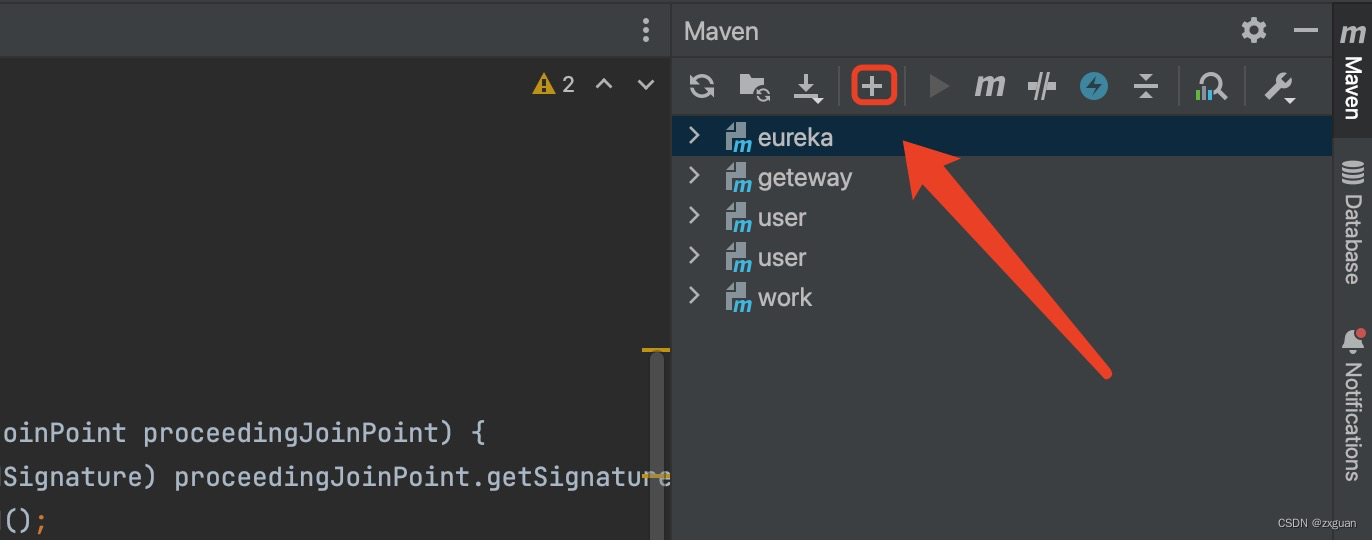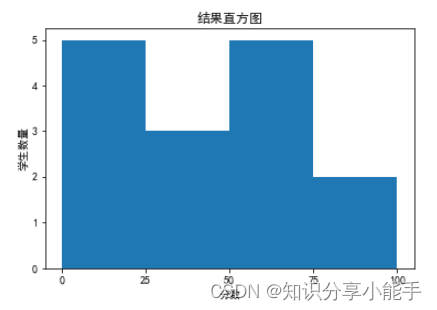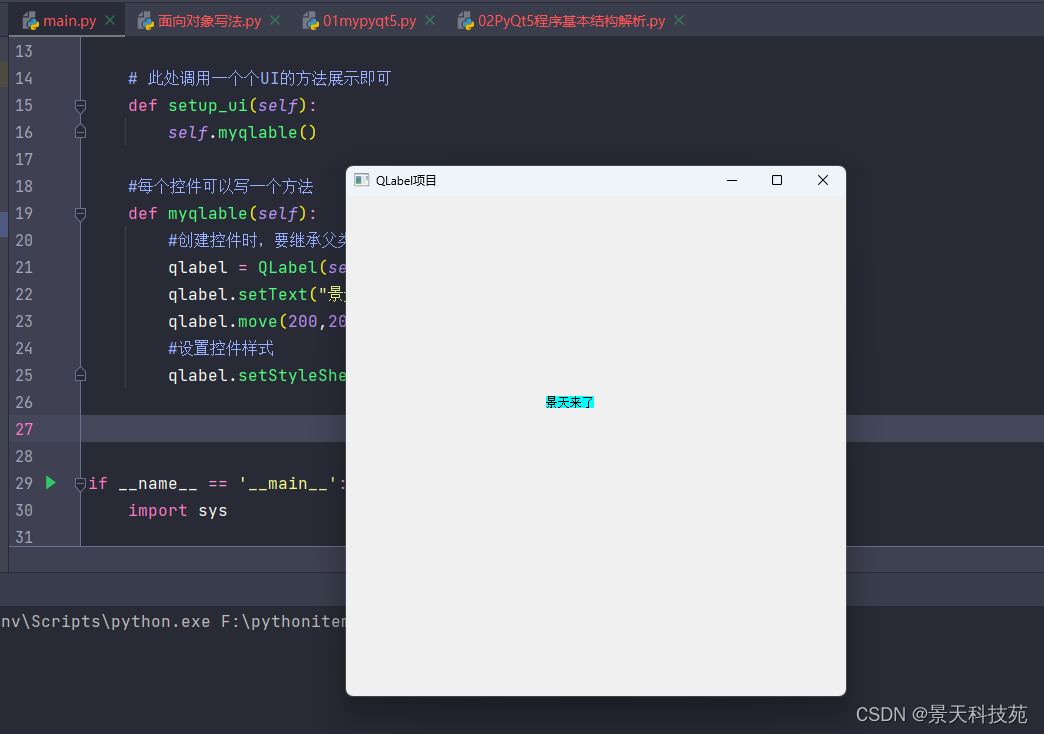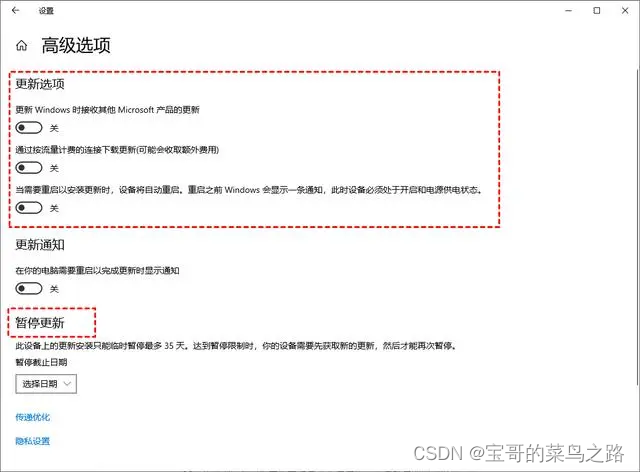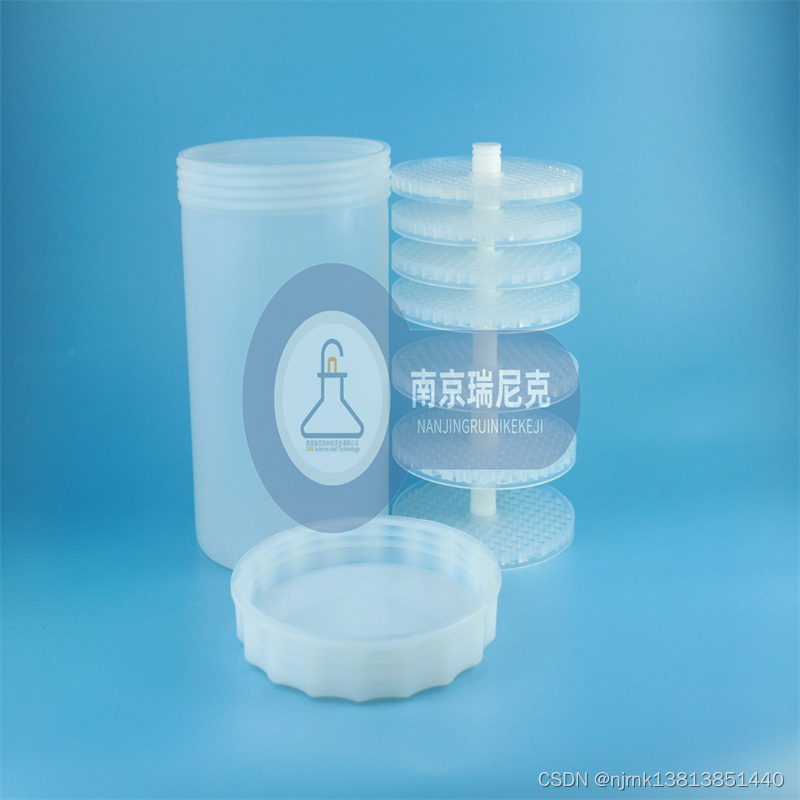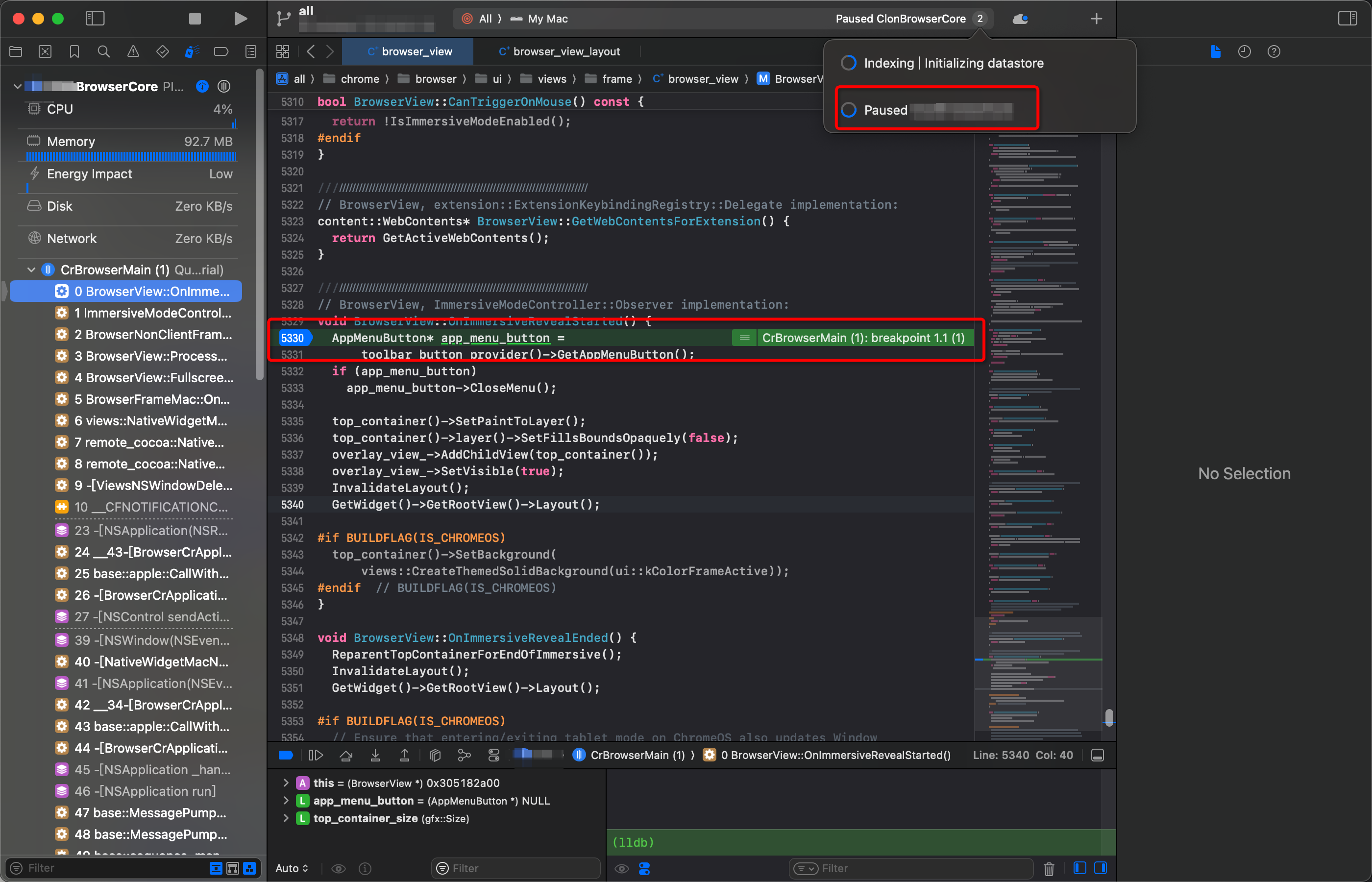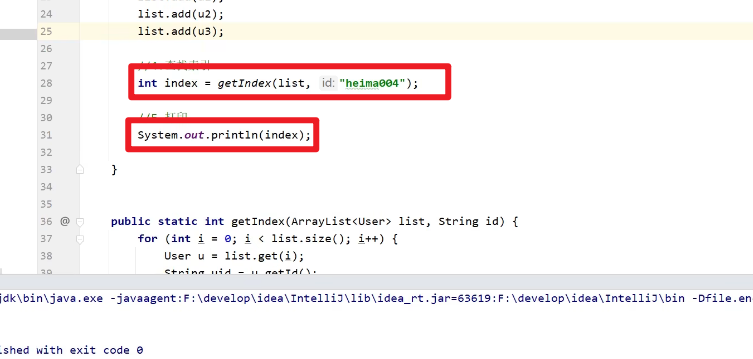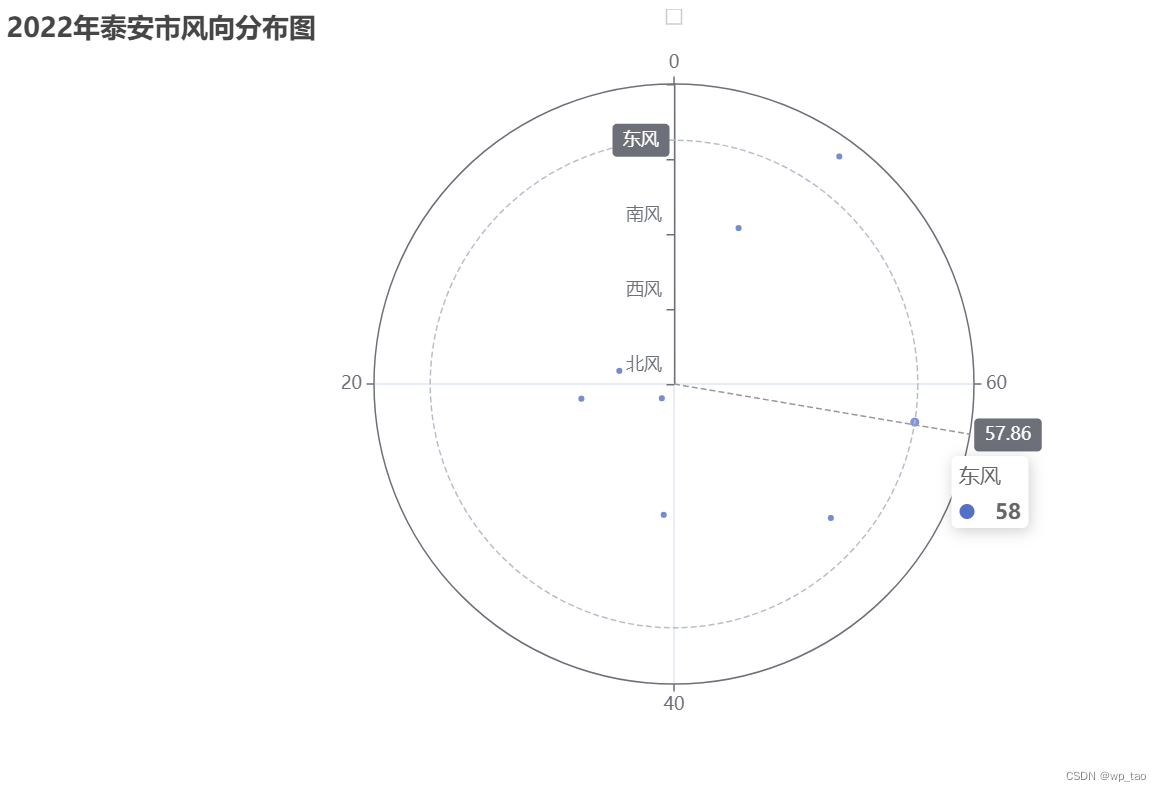一、导言
ASF-YOLO结合空间和尺度特征以实现精确且快速的细胞实例分割。在YOLO分割框架的基础上,通过引入尺度序列特征融合(SSFF)模块来增强网络的多尺度信息提取能力,并利用三重特征编码器(TFE)模块融合不同尺度的特征图以增加细节信息。此外,还引入了通道和位置注意力机制(CPAM),整合SSFF和TFE模块,专注于有信息的通道和与小物体空间位置相关的特征,从而提升检测和分割性能。实验验证显示,ASF-YOLO模型在两个细胞数据集上取得了显著的分割精度和速度,包括在2018年数据科学碗数据集上的框mAP为0.91,掩码mAP为0.887,推理速度为47.3 FPS,优于当时最先进的方法。
优点:
- 创新的结构设计:ASF-YOLO创新性地融合了尺度序列特征,有效处理不同大小、方向和长宽比的细胞,特别是对于小目标的分割具有显著效果。
- 高效与准确并重:模型在保持高分割精度的同时,实现了较快的推理速度,这对于临床应用来说至关重要。
- 注意力机制的集成:通过CPAM,模型能够动态调整对关键通道和空间位置的聚焦,提高了对细胞实例的识别和分割能力。
- 性能超越现有方法:在多个细胞分割基准数据集上,ASF-YOLO的性能超越了包括CNN和其他改进型YOLO在内的多种先进方法。
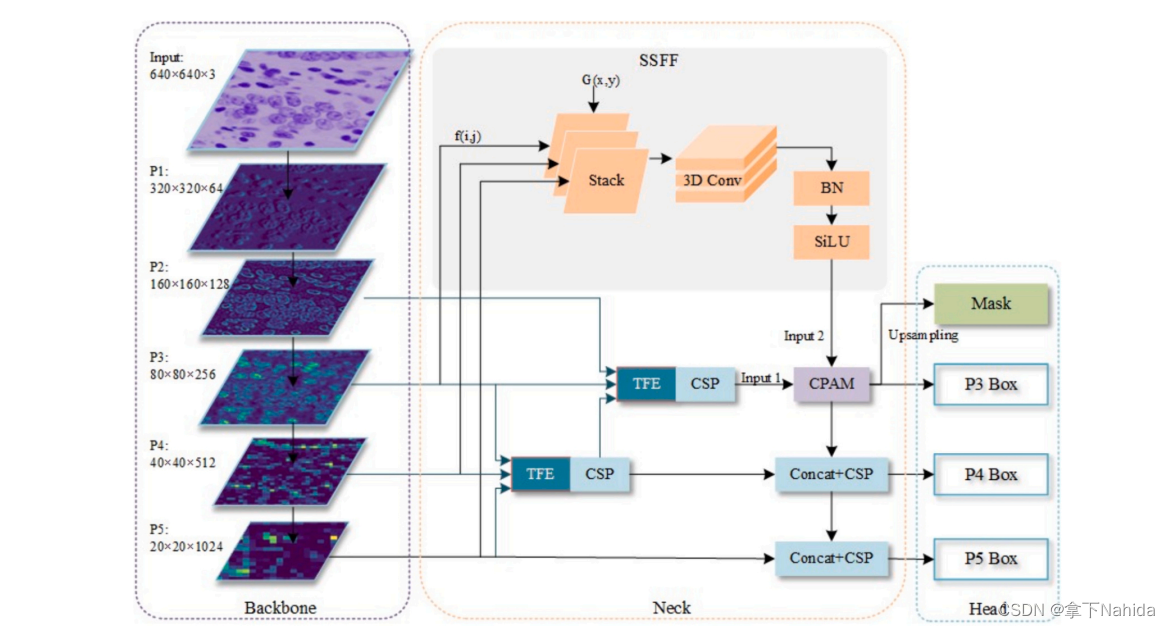
二、准备工作
首先在YOLOv5/v7的models文件夹下新建文件asfyolo.py,导入如下代码
from models.common import *
class Zoom_cat(nn.Module):
def __init__(self):
super().__init__()
def forward(self, x):
l, m, s = x[0], x[1], x[2]
tgt_size = m.shape[2:]
l = F.adaptive_max_pool2d(l, tgt_size) + F.adaptive_avg_pool2d(l, tgt_size)
s = F.interpolate(s, m.shape[2:], mode='nearest')
lms = torch.cat([l, m, s], dim=1)
return lms
class ScalSeq(nn.Module):
def __init__(self, inc, channel):
super(ScalSeq, self).__init__()
self.conv0 = Conv(inc[0], channel, 1)
self.conv1 = Conv(inc[1], channel, 1)
self.conv2 = Conv(inc[2], channel, 1)
self.conv3d = nn.Conv3d(channel, channel, kernel_size=(1, 1, 1))
self.bn = nn.BatchNorm3d(channel)
self.act = nn.LeakyReLU(0.1)
self.pool_3d = nn.MaxPool3d(kernel_size=(3, 1, 1))
def forward(self, x):
p3, p4, p5 = x[0], x[1], x[2]
p3 = self.conv0(p3)
p4_2 = self.conv1(p4)
p4_2 = F.interpolate(p4_2, p3.size()[2:], mode='nearest')
p5_2 = self.conv2(p5)
p5_2 = F.interpolate(p5_2, p3.size()[2:], mode='nearest')
p3_3d = torch.unsqueeze(p3, -3)
p4_3d = torch.unsqueeze(p4_2, -3)
p5_3d = torch.unsqueeze(p5_2, -3)
combine = torch.cat([p3_3d, p4_3d, p5_3d], dim=2)
conv_3d = self.conv3d(combine)
bn = self.bn(conv_3d)
act = self.act(bn)
x = self.pool_3d(act)
x = torch.squeeze(x, 2)
return x
class Add(nn.Module):
# Concatenate a list of tensors along dimension
def __init__(self):
super().__init__()
def forward(self, x):
input1, input2 = x[0], x[1]
x = input1 + input2
return x
class channel_att(nn.Module):
def __init__(self, channel, b=1, gamma=2):
super(channel_att, self).__init__()
kernel_size = int(abs((math.log(channel, 2) + b) / gamma))
kernel_size = kernel_size if kernel_size % 2 else kernel_size + 1
self.avg_pool = nn.AdaptiveAvgPool2d(1)
self.conv = nn.Conv1d(1, 1, kernel_size=kernel_size, padding=(kernel_size - 1) // 2, bias=False)
self.sigmoid = nn.Sigmoid()
def forward(self, x):
y = self.avg_pool(x)
y = y.squeeze(-1)
y = y.transpose(-1, -2)
y = self.conv(y).transpose(-1, -2).unsqueeze(-1)
y = self.sigmoid(y)
return x * y.expand_as(x)
class local_att(nn.Module):
def __init__(self, channel, reduction=16):
super(local_att, self).__init__()
self.conv_1x1 = nn.Conv2d(in_channels=channel, out_channels=channel // reduction, kernel_size=1, stride=1,
bias=False)
self.relu = nn.ReLU()
self.bn = nn.BatchNorm2d(channel // reduction)
self.F_h = nn.Conv2d(in_channels=channel // reduction, out_channels=channel, kernel_size=1, stride=1,
bias=False)
self.F_w = nn.Conv2d(in_channels=channel // reduction, out_channels=channel, kernel_size=1, stride=1,
bias=False)
self.sigmoid_h = nn.Sigmoid()
self.sigmoid_w = nn.Sigmoid()
def forward(self, x):
_, _, h, w = x.size()
x_h = torch.mean(x, dim=3, keepdim=True).permute(0, 1, 3, 2)
x_w = torch.mean(x, dim=2, keepdim=True)
x_cat_conv_relu = self.relu(self.bn(self.conv_1x1(torch.cat((x_h, x_w), 3))))
x_cat_conv_split_h, x_cat_conv_split_w = x_cat_conv_relu.split([h, w], 3)
s_h = self.sigmoid_h(self.F_h(x_cat_conv_split_h.permute(0, 1, 3, 2)))
s_w = self.sigmoid_w(self.F_w(x_cat_conv_split_w))
out = x * s_h.expand_as(x) * s_w.expand_as(x)
return out
class attention_model(nn.Module):
# Concatenate a list of tensors along dimension
def __init__(self, ch=256):
super().__init__()
self.channel_att = channel_att(ch)
self.local_att = local_att(ch)
def forward(self, x):
input1, input2 = x[0], x[1]
input1 = self.channel_att(input1)
x = input1 + input2
x = self.local_att(x)
return x
其次在在YOLOv5/v7项目文件下的models/yolo.py中在文件首部添加代码
from models.asfyolo import *并搜索def parse_model(d, ch)
定位到如下行添加以下代码
elif m is Zoom_cat:
c2 = sum(ch[x] for x in f)
elif m is Add:
c2 = ch[f[-1]]
elif m is attention_model:
c2 = ch[f[-1]]
args = [c2]
elif m is ScalSeq:
c1 = [ch[x] for x in f]
c2 = make_divisible(args[0] * gw, 8)
args = [c1, c2]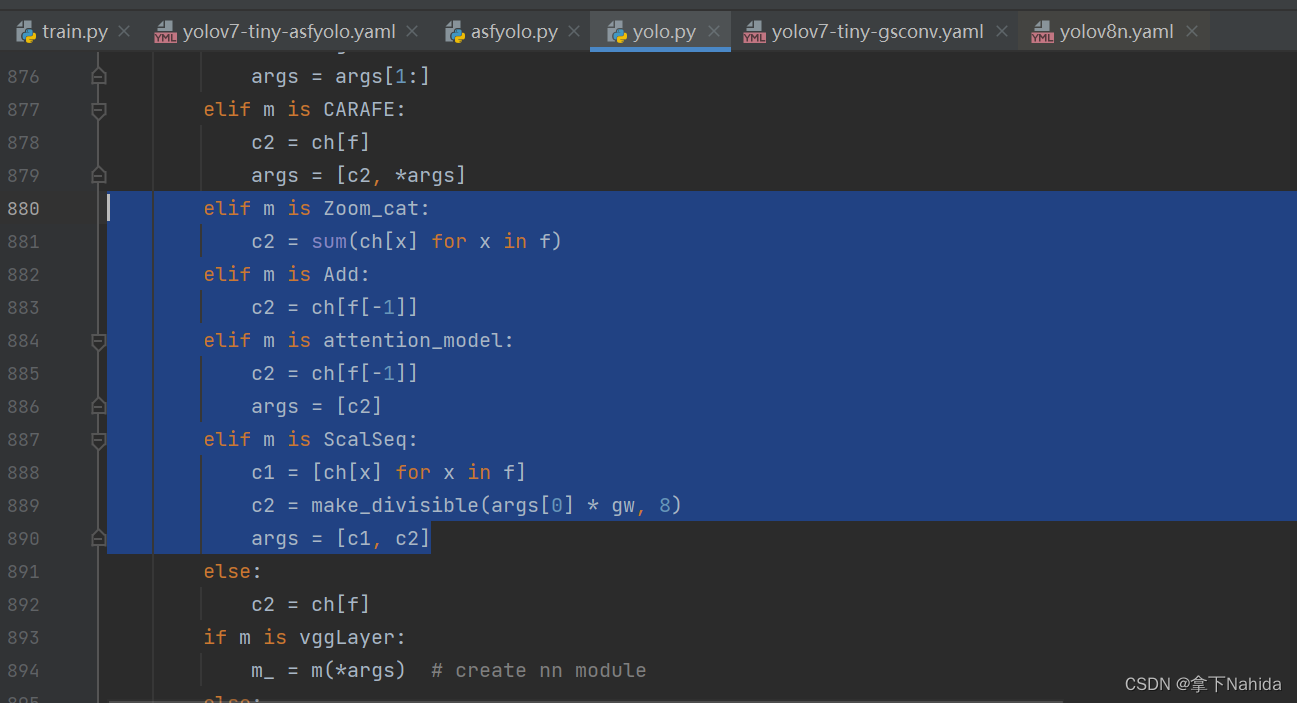
三、YOLOv7-tiny改进工作
完成二后,在YOLOv7项目文件下的models文件夹下创建新的文件yolov7-tiny-asfyolo.yaml,导入如下代码。
# parameters
nc: 80 # number of classes
depth_multiple: 1.0 # model depth multiple
width_multiple: 1.0 # layer channel multiple
# anchors
anchors:
- [10,13, 16,30, 33,23] # P3/8
- [30,61, 62,45, 59,119] # P4/16
- [116,90, 156,198, 373,326] # P5/32
# yolov7-tiny backbone
backbone:
# [from, number, module, args] c2, k=1, s=1, p=None, g=1, act=True
[[-1, 1, Conv, [32, 3, 2, None, 1, nn.LeakyReLU(0.1)]], # 0-P1/2
[-1, 1, Conv, [64, 3, 2, None, 1, nn.LeakyReLU(0.1)]], # 1-P2/4
[-1, 1, Conv, [32, 1, 1, None, 1, nn.LeakyReLU(0.1)]],
[-2, 1, Conv, [32, 1, 1, None, 1, nn.LeakyReLU(0.1)]],
[-1, 1, Conv, [32, 3, 1, None, 1, nn.LeakyReLU(0.1)]],
[-1, 1, Conv, [32, 3, 1, None, 1, nn.LeakyReLU(0.1)]],
[[-1, -2, -3, -4], 1, Concat, [1]],
[-1, 1, Conv, [64, 1, 1, None, 1, nn.LeakyReLU(0.1)]], # 7
[-1, 1, MP, []], # 8-P3/8
[-1, 1, Conv, [64, 1, 1, None, 1, nn.LeakyReLU(0.1)]],
[-2, 1, Conv, [64, 1, 1, None, 1, nn.LeakyReLU(0.1)]],
[-1, 1, Conv, [64, 3, 1, None, 1, nn.LeakyReLU(0.1)]],
[-1, 1, Conv, [64, 3, 1, None, 1, nn.LeakyReLU(0.1)]],
[[-1, -2, -3, -4], 1, Concat, [1]],
[-1, 1, Conv, [128, 1, 1, None, 1, nn.LeakyReLU(0.1)]], # 14
[-1, 1, MP, []], # 15-P4/16
[-1, 1, Conv, [128, 1, 1, None, 1, nn.LeakyReLU(0.1)]],
[-2, 1, Conv, [128, 1, 1, None, 1, nn.LeakyReLU(0.1)]],
[-1, 1, Conv, [128, 3, 1, None, 1, nn.LeakyReLU(0.1)]],
[-1, 1, Conv, [128, 3, 1, None, 1, nn.LeakyReLU(0.1)]],
[[-1, -2, -3, -4], 1, Concat, [1]],
[-1, 1, Conv, [256, 1, 1, None, 1, nn.LeakyReLU(0.1)]], # 21
[-1, 1, MP, []], # 22-P5/32
[-1, 1, Conv, [256, 1, 1, None, 1, nn.LeakyReLU(0.1)]],
[-2, 1, Conv, [256, 1, 1, None, 1, nn.LeakyReLU(0.1)]],
[-1, 1, Conv, [256, 3, 1, None, 1, nn.LeakyReLU(0.1)]],
[-1, 1, Conv, [256, 3, 1, None, 1, nn.LeakyReLU(0.1)]],
[[-1, -2, -3, -4], 1, Concat, [1]],
[-1, 1, Conv, [512, 1, 1, None, 1, nn.LeakyReLU(0.1)]], # 28
]
# yolov7-tiny head
head:
[[-1, 1, v7tiny_SPP, [256]], # 29
[-1, 1, Conv, [256, 1, 1, None, 1, nn.LeakyReLU(0.1)]],
[14, 1, Conv, [256, 1, 1, None, 1, nn.LeakyReLU(0.1)]],
[[-1, 21, -2], 1, Zoom_cat, []],
[-1, 1, Conv, [64, 1, 1, None, 1, nn.LeakyReLU(0.1)]],
[-2, 1, Conv, [64, 1, 1, None, 1, nn.LeakyReLU(0.1)]],
[-1, 1, Conv, [64, 3, 1, None, 1, nn.LeakyReLU(0.1)]],
[-1, 1, Conv, [64, 3, 1, None, 1, nn.LeakyReLU(0.1)]],
[[-1, -2, -3, -4], 1, Concat, [1]],
[-1, 1, Conv, [128, 1, 1, None, 1, nn.LeakyReLU(0.1)]], # 38
[-1, 1, Conv, [128, 1, 1, None, 1, nn.LeakyReLU(0.1)]],
[7, 1, Conv, [128, 1, 1, None, 1, nn.LeakyReLU(0.1)]], # 40
[[-1, 14, -2], 1, Zoom_cat, []],
[-1, 1, Conv, [32, 1, 1, None, 1, nn.LeakyReLU(0.1)]],
[-2, 1, Conv, [32, 1, 1, None, 1, nn.LeakyReLU(0.1)]],
[-1, 1, Conv, [32, 3, 1, None, 1, nn.LeakyReLU(0.1)]],
[-1, 1, Conv, [32, 3, 1, None, 1, nn.LeakyReLU(0.1)]],
[[-1, -2, -3, -4], 1, Concat, [1]],
[-1, 1, Conv, [64, 1, 1, None, 1, nn.LeakyReLU(0.1)]], # 47
[-1, 1, Conv, [128, 3, 2, None, 1, nn.LeakyReLU(0.1)]],
[[-1, 38], 1, Concat, [1]],
[-1, 1, Conv, [64, 1, 1, None, 1, nn.LeakyReLU(0.1)]],
[-2, 1, Conv, [64, 1, 1, None, 1, nn.LeakyReLU(0.1)]],
[-1, 1, Conv, [64, 3, 1, None, 1, nn.LeakyReLU(0.1)]],
[-1, 1, Conv, [64, 3, 1, None, 1, nn.LeakyReLU(0.1)]],
[[-1, -2, -3, -4], 1, Concat, [1]],
[-1, 1, Conv, [128, 1, 1, None, 1, nn.LeakyReLU(0.1)]], # 55
[-1, 1, Conv, [256, 3, 2, None, 1, nn.LeakyReLU(0.1)]],
[[-1, 29], 1, Concat, [1]],
[-1, 1, Conv, [128, 1, 1, None, 1, nn.LeakyReLU(0.1)]],
[-2, 1, Conv, [128, 1, 1, None, 1, nn.LeakyReLU(0.1)]],
[-1, 1, Conv, [128, 3, 1, None, 1, nn.LeakyReLU(0.1)]],
[-1, 1, Conv, [128, 3, 1, None, 1, nn.LeakyReLU(0.1)]],
[[-1, -2, -3, -4], 1, Concat, [1]],
[-1, 1, Conv, [256, 1, 1, None, 1, nn.LeakyReLU(0.1)]], # 63
[[14, 21, 28], 1, ScalSeq, [64]],
[[47, -1], 1, attention_model, []], #65
[65, 1, Conv, [128, 3, 1, None, 1, nn.LeakyReLU(0.1)]],
[63, 1, Conv, [256, 3, 1, None, 1, nn.LeakyReLU(0.1)]],
[55, 1, Conv, [512, 3, 1, None, 1, nn.LeakyReLU(0.1)]],
[[66, 67, 68], 1, IDetect, [nc, anchors]], # Detect(P3, P4, P5)
]
from n params module arguments
0 -1 1 928 models.common.Conv [3, 32, 3, 2, None, 1, LeakyReLU(negative_slope=0.1)]
1 -1 1 18560 models.common.Conv [32, 64, 3, 2, None, 1, LeakyReLU(negative_slope=0.1)]
2 -1 1 2112 models.common.Conv [64, 32, 1, 1, None, 1, LeakyReLU(negative_slope=0.1)]
3 -2 1 2112 models.common.Conv [64, 32, 1, 1, None, 1, LeakyReLU(negative_slope=0.1)]
4 -1 1 9280 models.common.Conv [32, 32, 3, 1, None, 1, LeakyReLU(negative_slope=0.1)]
5 -1 1 9280 models.common.Conv [32, 32, 3, 1, None, 1, LeakyReLU(negative_slope=0.1)]
6 [-1, -2, -3, -4] 1 0 models.common.Concat [1]
7 -1 1 8320 models.common.Conv [128, 64, 1, 1, None, 1, LeakyReLU(negative_slope=0.1)]
8 -1 1 0 models.common.MP []
9 -1 1 4224 models.common.Conv [64, 64, 1, 1, None, 1, LeakyReLU(negative_slope=0.1)]
10 -2 1 4224 models.common.Conv [64, 64, 1, 1, None, 1, LeakyReLU(negative_slope=0.1)]
11 -1 1 36992 models.common.Conv [64, 64, 3, 1, None, 1, LeakyReLU(negative_slope=0.1)]
12 -1 1 36992 models.common.Conv [64, 64, 3, 1, None, 1, LeakyReLU(negative_slope=0.1)]
13 [-1, -2, -3, -4] 1 0 models.common.Concat [1]
14 -1 1 33024 models.common.Conv [256, 128, 1, 1, None, 1, LeakyReLU(negative_slope=0.1)]
15 -1 1 0 models.common.MP []
16 -1 1 16640 models.common.Conv [128, 128, 1, 1, None, 1, LeakyReLU(negative_slope=0.1)]
17 -2 1 16640 models.common.Conv [128, 128, 1, 1, None, 1, LeakyReLU(negative_slope=0.1)]
18 -1 1 147712 models.common.Conv [128, 128, 3, 1, None, 1, LeakyReLU(negative_slope=0.1)]
19 -1 1 147712 models.common.Conv [128, 128, 3, 1, None, 1, LeakyReLU(negative_slope=0.1)]
20 [-1, -2, -3, -4] 1 0 models.common.Concat [1]
21 -1 1 131584 models.common.Conv [512, 256, 1, 1, None, 1, LeakyReLU(negative_slope=0.1)]
22 -1 1 0 models.common.MP []
23 -1 1 66048 models.common.Conv [256, 256, 1, 1, None, 1, LeakyReLU(negative_slope=0.1)]
24 -2 1 66048 models.common.Conv [256, 256, 1, 1, None, 1, LeakyReLU(negative_slope=0.1)]
25 -1 1 590336 models.common.Conv [256, 256, 3, 1, None, 1, LeakyReLU(negative_slope=0.1)]
26 -1 1 590336 models.common.Conv [256, 256, 3, 1, None, 1, LeakyReLU(negative_slope=0.1)]
27 [-1, -2, -3, -4] 1 0 models.common.Concat [1]
28 -1 1 525312 models.common.Conv [1024, 512, 1, 1, None, 1, LeakyReLU(negative_slope=0.1)]
29 -1 1 657408 models.common.v7tiny_SPP [512, 256]
30 -1 1 66048 models.common.Conv [256, 256, 1, 1, None, 1, LeakyReLU(negative_slope=0.1)]
31 14 1 33280 models.common.Conv [128, 256, 1, 1, None, 1, LeakyReLU(negative_slope=0.1)]
32 [-1, 21, -2] 1 0 models.asfyolo.Zoom_cat []
33 -1 1 49280 models.common.Conv [768, 64, 1, 1, None, 1, LeakyReLU(negative_slope=0.1)]
34 -2 1 49280 models.common.Conv [768, 64, 1, 1, None, 1, LeakyReLU(negative_slope=0.1)]
35 -1 1 36992 models.common.Conv [64, 64, 3, 1, None, 1, LeakyReLU(negative_slope=0.1)]
36 -1 1 36992 models.common.Conv [64, 64, 3, 1, None, 1, LeakyReLU(negative_slope=0.1)]
37 [-1, -2, -3, -4] 1 0 models.common.Concat [1]
38 -1 1 33024 models.common.Conv [256, 128, 1, 1, None, 1, LeakyReLU(negative_slope=0.1)]
39 -1 1 16640 models.common.Conv [128, 128, 1, 1, None, 1, LeakyReLU(negative_slope=0.1)]
40 7 1 8448 models.common.Conv [64, 128, 1, 1, None, 1, LeakyReLU(negative_slope=0.1)]
41 [-1, 14, -2] 1 0 models.asfyolo.Zoom_cat []
42 -1 1 12352 models.common.Conv [384, 32, 1, 1, None, 1, LeakyReLU(negative_slope=0.1)]
43 -2 1 12352 models.common.Conv [384, 32, 1, 1, None, 1, LeakyReLU(negative_slope=0.1)]
44 -1 1 9280 models.common.Conv [32, 32, 3, 1, None, 1, LeakyReLU(negative_slope=0.1)]
45 -1 1 9280 models.common.Conv [32, 32, 3, 1, None, 1, LeakyReLU(negative_slope=0.1)]
46 [-1, -2, -3, -4] 1 0 models.common.Concat [1]
47 -1 1 8320 models.common.Conv [128, 64, 1, 1, None, 1, LeakyReLU(negative_slope=0.1)]
48 -1 1 73984 models.common.Conv [64, 128, 3, 2, None, 1, LeakyReLU(negative_slope=0.1)]
49 [-1, 38] 1 0 models.common.Concat [1]
50 -1 1 16512 models.common.Conv [256, 64, 1, 1, None, 1, LeakyReLU(negative_slope=0.1)]
51 -2 1 16512 models.common.Conv [256, 64, 1, 1, None, 1, LeakyReLU(negative_slope=0.1)]
52 -1 1 36992 models.common.Conv [64, 64, 3, 1, None, 1, LeakyReLU(negative_slope=0.1)]
53 -1 1 36992 models.common.Conv [64, 64, 3, 1, None, 1, LeakyReLU(negative_slope=0.1)]
54 [-1, -2, -3, -4] 1 0 models.common.Concat [1]
55 -1 1 33024 models.common.Conv [256, 128, 1, 1, None, 1, LeakyReLU(negative_slope=0.1)]
56 -1 1 295424 models.common.Conv [128, 256, 3, 2, None, 1, LeakyReLU(negative_slope=0.1)]
57 [-1, 29] 1 0 models.common.Concat [1]
58 -1 1 65792 models.common.Conv [512, 128, 1, 1, None, 1, LeakyReLU(negative_slope=0.1)]
59 -2 1 65792 models.common.Conv [512, 128, 1, 1, None, 1, LeakyReLU(negative_slope=0.1)]
60 -1 1 147712 models.common.Conv [128, 128, 3, 1, None, 1, LeakyReLU(negative_slope=0.1)]
61 -1 1 147712 models.common.Conv [128, 128, 3, 1, None, 1, LeakyReLU(negative_slope=0.1)]
62 [-1, -2, -3, -4] 1 0 models.common.Concat [1]
63 -1 1 131584 models.common.Conv [512, 256, 1, 1, None, 1, LeakyReLU(negative_slope=0.1)]
64 [14, 21, 28] 1 62016 models.asfyolo.ScalSeq [[128, 256, 512], 64]
65 [47, -1] 1 779 models.asfyolo.attention_model [64]
66 65 1 73984 models.common.Conv [64, 128, 3, 1, None, 1, LeakyReLU(negative_slope=0.1)]
67 63 1 590336 models.common.Conv [256, 256, 3, 1, None, 1, LeakyReLU(negative_slope=0.1)]
68 55 1 590848 models.common.Conv [128, 512, 3, 1, None, 1, LeakyReLU(negative_slope=0.1)]
69 [66, 67, 68] 1 17132 models.yolo.IDetect [1, [[10, 13, 16, 30, 33, 23], [30, 61, 62, 45, 59, 119], [116, 90, 156, 198, 373, 326]], [128, 256, 512]]
Model Summary: 288 layers, 5906519 parameters, 5906519 gradients, 15.2 GFLOPS运行后若打印出如上文本代表改进成功。
四、YOLOv5s改进工作
完成二后,在YOLOv5项目文件下的models文件夹下创建新的文件yolov5s-asfyolo.yaml,导入如下代码。
# Parameters
nc: 80 # number of classes
depth_multiple: 0.33 # model depth multiple
width_multiple: 0.50 # layer channel multiple
anchors:
- [10,13, 16,30, 33,23] # P3/8
- [30,61, 62,45, 59,119] # P4/16
- [116,90, 156,198, 373,326] # P5/32
# YOLOv5 v6.0 backbone
backbone:
# [from, number, module, args]
[[-1, 1, Conv, [64, 6, 2, 2]], # 0-P1/2
[-1, 1, Conv, [128, 3, 2]], # 1-P2/4
[-1, 3, C3, [128]],
[-1, 1, Conv, [256, 3, 2]], # 3-P3/8
[-1, 6, C3, [256]],
[-1, 1, Conv, [512, 3, 2]], # 5-P4/16
[-1, 9, C3, [512]],
[-1, 1, Conv, [1024, 3, 2]], # 7-P5/32
[-1, 3, C3, [1024]],
[-1, 1, SPPF, [1024, 5]], # 9
]
# YOLOv5 v6.0 head
head:
[[-1, 1, Conv, [512, 1, 1]], #10
[4, 1, Conv, [512, 1, 1]], #11
[[-1, 6, -2], 1, Zoom_cat, []], # 12 cat backbone P4
[-1, 3, C3, [512, False]], # 13
[-1, 1, Conv, [256, 1, 1]], #14
[2, 1, Conv, [256, 1, 1]], #15
[[-1, 4, -2], 1, Zoom_cat, []], #16 cat backbone P3
[-1, 3, C3, [256, False]], # 17 (P3/8-small)
[-1, 1, Conv, [256, 3, 2]], #18
[[-1, 14], 1, Concat, [1]], #19 cat head P4
[-1, 3, C3, [512, False]], # 20 (P4/16-medium)
[-1, 1, Conv, [512, 3, 2]], #21
[[-1, 10], 1, Concat, [1]], #22 cat head P5
[-1, 3, C3, [1024, False]], # 23 (P5/32-large)
[[4, 6, 8], 1, ScalSeq, [256]],
[[17, -1], 1, attention_model, []], #25
[[25, 20, 23], 1, Detect, [nc, anchors]], # Detect(P3, P4, P5)
]
from n params module arguments
0 -1 1 3520 models.common.Conv [3, 32, 6, 2, 2]
1 -1 1 18560 models.common.Conv [32, 64, 3, 2]
2 -1 1 18816 models.common.C3 [64, 64, 1]
3 -1 1 73984 models.common.Conv [64, 128, 3, 2]
4 -1 2 115712 models.common.C3 [128, 128, 2]
5 -1 1 295424 models.common.Conv [128, 256, 3, 2]
6 -1 3 625152 models.common.C3 [256, 256, 3]
7 -1 1 1180672 models.common.Conv [256, 512, 3, 2]
8 -1 1 1182720 models.common.C3 [512, 512, 1]
9 -1 1 656896 models.common.SPPF [512, 512, 5]
10 -1 1 131584 models.common.Conv [512, 256, 1, 1]
11 4 1 33280 models.common.Conv [128, 256, 1, 1]
12 [-1, 6, -2] 1 0 models.asfyolo.Zoom_cat []
13 -1 1 427520 models.common.C3 [768, 256, 1, False]
14 -1 1 33024 models.common.Conv [256, 128, 1, 1]
15 2 1 8448 models.common.Conv [64, 128, 1, 1]
16 [-1, 4, -2] 1 0 models.asfyolo.Zoom_cat []
17 -1 1 107264 models.common.C3 [384, 128, 1, False]
18 -1 1 147712 models.common.Conv [128, 128, 3, 2]
19 [-1, 14] 1 0 models.common.Concat [1]
20 -1 1 296448 models.common.C3 [256, 256, 1, False]
21 -1 1 590336 models.common.Conv [256, 256, 3, 2]
22 [-1, 10] 1 0 models.common.Concat [1]
23 -1 1 1182720 models.common.C3 [512, 512, 1, False]
24 [4, 6, 8] 1 132224 models.asfyolo.ScalSeq [[128, 256, 512], 128]
25 [17, -1] 1 3093 models.asfyolo.attention_model [128]
26 [25, 20, 23] 1 16182 models.yolo.Detect [1, [[10, 13, 16, 30, 33, 23], [30, 61, 62, 45, 59, 119], [116, 90, 156, 198, 373, 326]], [128, 256, 512]]
Model Summary: 306 layers, 7281291 parameters, 7281291 gradients, 18.3 GFLOPs
运行后若打印出如上文本代表改进成功。
五、YOLOv5n改进工作
完成二后,在YOLOv5项目文件下的models文件夹下创建新的文件yolov5n-asfyolo.yaml,导入如下代码。
# Parameters
nc: 80 # number of classes
depth_multiple: 0.33 # model depth multiple
width_multiple: 0.25 # layer channel multiple
anchors:
- [10,13, 16,30, 33,23] # P3/8
- [30,61, 62,45, 59,119] # P4/16
- [116,90, 156,198, 373,326] # P5/32
# YOLOv5 v6.0 backbone
backbone:
# [from, number, module, args]
[[-1, 1, Conv, [64, 6, 2, 2]], # 0-P1/2
[-1, 1, Conv, [128, 3, 2]], # 1-P2/4
[-1, 3, C3, [128]],
[-1, 1, Conv, [256, 3, 2]], # 3-P3/8
[-1, 6, C3, [256]],
[-1, 1, Conv, [512, 3, 2]], # 5-P4/16
[-1, 9, C3, [512]],
[-1, 1, Conv, [1024, 3, 2]], # 7-P5/32
[-1, 3, C3, [1024]],
[-1, 1, SPPF, [1024, 5]], # 9
]
# YOLOv5 v6.0 head
head:
[[-1, 1, Conv, [512, 1, 1]], #10
[4, 1, Conv, [512, 1, 1]], #11
[[-1, 6, -2], 1, Zoom_cat, []], # 12 cat backbone P4
[-1, 3, C3, [512, False]], # 13
[-1, 1, Conv, [256, 1, 1]], #14
[2, 1, Conv, [256, 1, 1]], #15
[[-1, 4, -2], 1, Zoom_cat, []], #16 cat backbone P3
[-1, 3, C3, [256, False]], # 17 (P3/8-small)
[-1, 1, Conv, [256, 3, 2]], #18
[[-1, 14], 1, Concat, [1]], #19 cat head P4
[-1, 3, C3, [512, False]], # 20 (P4/16-medium)
[-1, 1, Conv, [512, 3, 2]], #21
[[-1, 10], 1, Concat, [1]], #22 cat head P5
[-1, 3, C3, [1024, False]], # 23 (P5/32-large)
[[4, 6, 8], 1, ScalSeq, [256]],
[[17, -1], 1, attention_model, []], #25
[[25, 20, 23], 1, Detect, [nc, anchors]], # Detect(P3, P4, P5)
]
from n params module arguments
0 -1 1 1760 models.common.Conv [3, 16, 6, 2, 2]
1 -1 1 4672 models.common.Conv [16, 32, 3, 2]
2 -1 1 4800 models.common.C3 [32, 32, 1]
3 -1 1 18560 models.common.Conv [32, 64, 3, 2]
4 -1 2 29184 models.common.C3 [64, 64, 2]
5 -1 1 73984 models.common.Conv [64, 128, 3, 2]
6 -1 3 156928 models.common.C3 [128, 128, 3]
7 -1 1 295424 models.common.Conv [128, 256, 3, 2]
8 -1 1 296448 models.common.C3 [256, 256, 1]
9 -1 1 164608 models.common.SPPF [256, 256, 5]
10 -1 1 33024 models.common.Conv [256, 128, 1, 1]
11 4 1 8448 models.common.Conv [64, 128, 1, 1]
12 [-1, 6, -2] 1 0 models.asfyolo.Zoom_cat []
13 -1 1 107264 models.common.C3 [384, 128, 1, False]
14 -1 1 8320 models.common.Conv [128, 64, 1, 1]
15 2 1 2176 models.common.Conv [32, 64, 1, 1]
16 [-1, 4, -2] 1 0 models.asfyolo.Zoom_cat []
17 -1 1 27008 models.common.C3 [192, 64, 1, False]
18 -1 1 36992 models.common.Conv [64, 64, 3, 2]
19 [-1, 14] 1 0 models.common.Concat [1]
20 -1 1 74496 models.common.C3 [128, 128, 1, False]
21 -1 1 147712 models.common.Conv [128, 128, 3, 2]
22 [-1, 10] 1 0 models.common.Concat [1]
23 -1 1 296448 models.common.C3 [256, 256, 1, False]
24 [4, 6, 8] 1 33344 models.asfyolo.ScalSeq [[64, 128, 256], 64]
25 [17, -1] 1 779 models.asfyolo.attention_model [64]
26 [25, 20, 23] 1 8118 models.yolo.Detect [1, [[10, 13, 16, 30, 33, 23], [30, 61, 62, 45, 59, 119], [116, 90, 156, 198, 373, 326]], [64, 128, 256]]
Model Summary: 306 layers, 1830497 parameters, 1830497 gradients, 4.8 GFLOPs运行后打印如上代码说明改进成功。
更多文章产出中,主打简洁和准确,欢迎关注我,共同探讨!




